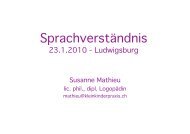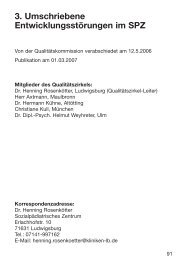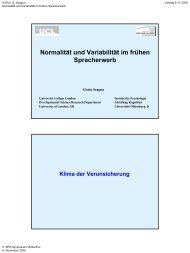(Central) Auditory Processing Disorders - Technical Report
(Central) Auditory Processing Disorders - Technical Report
(Central) Auditory Processing Disorders - Technical Report
- No tags were found...
You also want an ePaper? Increase the reach of your titles
YUMPU automatically turns print PDFs into web optimized ePapers that Google loves.
10 / 2005<br />
American Speech-Language-Hearing Association<br />
following response, cortical event-related<br />
potentials [P1, N1, P2, P300], mismatch negativity,<br />
topographical mapping). The use of<br />
electrophysiologic measures may be particularly<br />
useful in cases in which behavioral procedures<br />
are not feasible (e.g., infants and very<br />
young children), when there is suspicion of<br />
frank neurologic disorder, when a confirmation<br />
of behavioral findings is needed, or<br />
when behavioral findings are inconclusive.<br />
Test Interpretation<br />
There are several approaches audiologists may<br />
use to interpret results of diagnostic tests of (C)APD.<br />
While work continues to ascertain the gold standard<br />
against which (C)APD should be gauged, additional<br />
approaches to test interpretation will contribute to<br />
accurate and meaningful analysis of an individual’s<br />
test scores. In combination, these approaches assist<br />
audiologists and related professionals in differentially<br />
diagnosing (C)APD from disorders having<br />
overlapping behavioral attributes (e.g., ADHD, language<br />
disorder, cognitive disorder, LD).<br />
Absolute or norm-based interpretation, probably<br />
the most commonly used approach, involves judging<br />
an individual’s performance relative to group data<br />
from normal controls.<br />
Relative or patient-based interpretation refers to<br />
judging an individual’s performance on a given test<br />
relative to his or her own baseline. Patient-based interpretation<br />
may include:<br />
• Intratest analysis, which is the comparison of<br />
patterns observed within a given test that provides<br />
additional interpretive information (e.g.,<br />
ear difference scores, interhemispheric differences);<br />
• Intertest analysis, which is the comparison of<br />
trends observed across the diagnostic test battery<br />
that provides additional interpretive information<br />
(e.g., presence of patterns consistent<br />
with neuroscience principles, anatomical site<br />
of dysfunction, and comorbid clinical profiles);<br />
and<br />
• Cross-discipline analysis, which is the comparison<br />
of results observed across diagnostic<br />
tests of (C)APD and results from<br />
nonaudiological disciplines (e.g., speech-language,<br />
multimodality sensory function,<br />
psychoeducational, and cognitive test findings).<br />
Diagnosis of (C)APD generally requires performance<br />
deficits on the order of at least two standard<br />
deviations below the mean on two or more tests in<br />
the battery (Chermak & Musiek, 1997). The audiologist<br />
should be alert, however, to inconsistencies<br />
across tests that would signal the presence of a nonauditory<br />
confound rather than a (C)APD even when<br />
an individual meets this criterion (e.g., left-ear deficit<br />
on one dichotic speech task combined with rightear<br />
deficit on another). If poor performance is<br />
observed on only one test, the audiologist should<br />
withhold a diagnosis of (C)APD unless the client’s<br />
performance falls at least three standard deviations<br />
below the mean or when the finding is accompanied<br />
by significant functional difficulty in auditory behaviors<br />
reliant on the process assessed. Moreover, the<br />
audiologist should re-administer the sole test failed<br />
as well as another similar test that assesses the same<br />
process to confirm the initial findings.<br />
The interpretation of intertest and cross-discipline<br />
data should be correlated to well-established<br />
auditory neuroscience tenets or principles whenever<br />
possible, particularly as it relates to the identification<br />
of patterns indicative of anatomic site or region of<br />
dysfunction within the CANS (Bellis, 2003; Bellis &<br />
Ferre, 1999; Chermak & Musiek, 1997). The audiologist<br />
also should note qualitative indicators of behavior<br />
coincident to test performance (e.g., consistency<br />
of latency of response, distribution of errors across<br />
test trials), which might implicate cognitive factors<br />
(e.g., attention, memory), fatigue, motivation, or other<br />
sources of difficulty unrelated to (C)APD. When poor<br />
or inconsistent performance is found across all test<br />
results, regardless of the process measured or of when<br />
performance decrements occur over time and are alleviated<br />
by reinforcement, higher order cognitive,<br />
motivational, or related confounds should be suspected.<br />
Today, there exist classifications systems, or<br />
models, that are used to profile individuals who have<br />
been diagnosed with (C)APD (Bellis, 2003; Bellis &<br />
Ferre, 1999; Katz, 1992). Clinicians may find these<br />
models, which are based on evolving theoretical constructs,<br />
helpful in relating findings on tests of central<br />
auditory function to behavioral symptoms and areas<br />
of difficulty in the classroom, workplace, and other<br />
communicative environments. Each model uses the<br />
results of the central auditory test battery to build a<br />
profile that can be used to assist a multidisciplinary<br />
team in determining deficit-specific intervention<br />
strategies. Although these subprofiling methods may<br />
serve as useful guides in the interpretation of central<br />
auditory test results and development of deficit-focused<br />
intervention plans, it should be emphasized<br />
that use of these models is not universally accepted<br />
at the present time and additional research into these<br />
and other subprofiling methods is needed.







